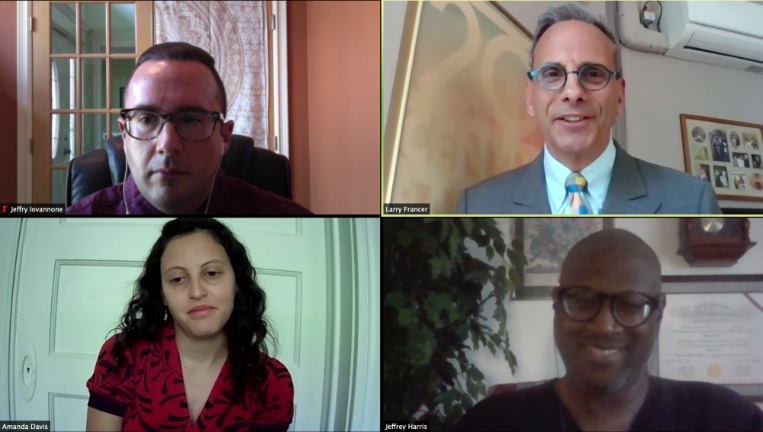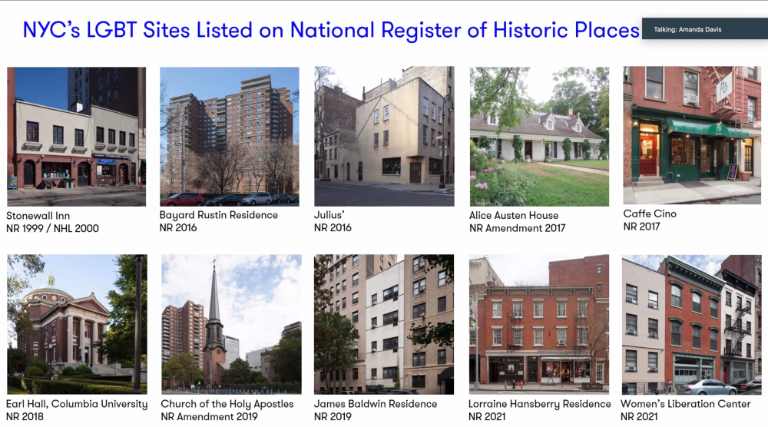The NYC LGBT Historic Sites Project, a local nonprofit advocating for recognition of historic buildings with queer pasts, lists the Stonewall Inn on its interactive map of LGBTQ+ sites in the city — along with over 350 additional, though perhaps lesser-known, sites of significance.
“The goal of the project is to broaden people’s knowledge of the city’s LGBT history, beyond the globally-recognized Stonewall Inn in Greenwich Village,” Project Manager Amanda Davis said during an online panel hosted by the Preservation League of New York State last Thursday. “And in doing so, help push the conversation forward in rethinking how we interpret historic sites.”
At last week’s event, Davis was joined by historic preservation consultant Jeffrey “Free” Harris and Jeffry Iovannone, who spotlights LGBTQ+ landmarks in a blog series for Preservation Buffalo Niagara, for brief presentations and a conversation moderated by Larry Francer, the associate director of the Landmark Society of Western New York. The panelists addressed the unique hurdles of nominating sites for formal recognition based specifically on their LGBTQ+-related histories, but also spoke to the impact that such designations hold for the queer community.
Davis, Harris and Iovannone presented detailed information on a selection of LGBTQ+ sites in New York, most already bearing landmark status. For a building to be nationally recognized as a landmark, it must be nominated to the National Register of Historic Places. The Stonewall Inn, Davis explained, was the first building in the U.S. to be recognized as a landmark for its significance as a site of LGBTQ+ history. Now, ten such sites in the city are similarly recognized by the state and national registers.
Trials and Tribulations
In addition to outlining the NYC LGBT Historic Sites Project’s mission, Davis also dove into the challenges facing those who wish to register buildings as landmarks for their roles in LGBTQ+ history. The group, led by historians with ties to Columbia University, has penned a “historic context statement” for New York City to help situate individual sites within a broader history of queer culture in an effort to make the process of reviewing a building for landmark status more straightforward. Still, other hurdles persist.
“Owner consent is needed for a property to be listed on the National Register ... and this can be a challenge when an owner doesn’t want to be associated with LGBT history,” Davis said.
Davis also mentioned that convincingly “identifying” historic figures as part of the LGBTQ+ community can prove difficult.
Beyond locating new sites for historic landmark recognition, Davis and others acknowledged that in some cases, pre-existing landmark listings must be amended to include reference to sites’ LGBTQ+ pasts, which may have originally been neglected. “History is not fixed,” Davis said. “We can go back in time and re-evaluate and include narratives that were left out.”
In other cases, sites of LGBTQ+ importance are in jeopardy of ceasing to exist altogether. “A lot of our sites are located in places that usually go through a great deal of change, neighborhoods that change,” explained Harris, whose presentation focused on African American LGBTQ+ historical sites. “They’re in areas that, you know, over time we see that they are gentrified or they’re torn down.”
In Western New York, there are currently no landmarks recognized exclusively for their ties to LGBTQ+ historical figures or events by the National Register of Historic Places — a reality which Iovannone hopes to soon change.
Underscoring LGBTQ+ Stories
The mission of Preservation Buffalo Niagara’s “Gay Places” initiative, which Iovannone cofounded in 2020, is not only to commemorate LGBTQ+ sites in Western New York, but also to shift the narrative that queer history is rooted solely in hotspots on either coast of the country.
“If we have sites in places like Buffalo or Rochester, right, that are listed on the National Register and have that sort of prestige and authenticity,” he explained, “it makes it much more, I think, difficult to ignore what happened outside of large cities on the coast.”
In addition to crafting blog posts that dive into LGBTQ+ history in the area and hosting informational events, Iovannone also broke ground on nominating the former home of transgender activist Peggie Ames, located in Clarence, New York, for landmark status with the National Register of Historic Places.
Presentations acknowledged that sites with LGBTQ+ significance can be appreciated even without official landmark status, especially through events that engage the local community, like walking tours. Still, Davis, Harris and Iovannone agreed that landmark status is a valuable way to recognize and legitimize the community’s history.
“There’s no question in my mind,” Harris said, “that the honorific of a National Register listing is important to people.”

